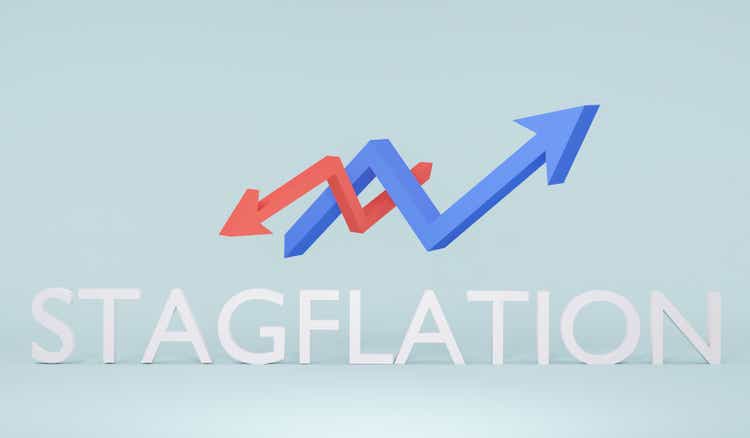Hoowy/iStock via Getty Images
Dealing with high inflation is never simple. With stagflation, it’s even more complicated.
Stagflation is typically marked by slow economic growth combined with relatively high unemployment and rising prices – think late 1970s and early 1980s. Concerns about stagflation have emerged because high inflation is widespread and growth is slowing in some markets. Spoiler alert: We’re not seeing stagflation yet. Unemployment is low and growth is uneven across sectors and geographies.
High inflation erodes the purchasing power of people’s income and wealth, and as that occurs, real spending can decelerate or even decline. Because inflation is unacceptably high, and so far above central banks’ targets for inflation, the Federal Reserve has encouraged tighter financial conditions, which will slow the economy.
If high inflation persists, it can raise inflation expectations, making it more difficult for central banks to squelch that inflation. That means central banks need to hit the monetary brakes even harder, having more of an impact on slowing the economy. That persistence is a distinguishing factor between a period of stagflation or a period of simply transitory high inflation.
The Fed is sending clear signals that controlling inflation is its top priority and could come at the expense of employment and economic growth. That would raise the risk of stagflation and have ripple effects across the globe.
Where inflation is going
Our PMI data from June show that for two months, service sector inflation, in terms of their costs, has exceeded that of manufacturing.
Price pressures are coming down on the commodity side, particularly in industrial metals. Our weekly Materials Price Index fell 3.5% in the week ended July 8, following a 2.4% decline the previous week. Even oil prices have relaxed somewhat in recent weeks due to weakening global demand. Still, the supply situation is keeping those costs extremely elevated – like the energy shocks seen during the stagflation of the 1970s.
The US appears to be close to a turning point in inflation. Our economists believe inflation will fall below 4% within a year. That’s partly because we’re already seeing significant declines in commodity prices. High inventories in some areas are leading to cutbacks in production as well as some return of price discounting in finished goods.
Yet, we don’t see high inflation everywhere. Unlike major advanced economies like the U.S. or Europe, mainland China’s economic growth is supply-led, propelled by business activities like manufacturing, and not by consumer purchases. Even though mainland China is experiencing high energy and commodity prices, which has lifted the country’s producer price inflation, consumer price inflation was just 2.5% year on year in June.
China’s zero-COVID policy could pose a risk to the global supply chain – and inflation – if the newer variants lead to more frequent and large-scale lockdowns.
Uneven growth
Demand growth across the four major developed economies – U.S., U.K., Eurozone, and Japan – has stalled after surging earlier in the year, according to our preliminary PMI data for July.
Growth remains strong in emerging markets such as India and Brazil. Mainland China has reopened after its most recent COVID lockdowns, and growth has picked up there. There, monetary policy is easing to support economic growth at a time when housing markets are in steep decline.
China faces the prospect of weak growth because its zero-COVID policy will remain in place at least through the first quarter of 2023. That will prevent the economy from functioning normally, and domestic demand will remain weak.
Mainland China is also exposed to external demand weakness with the rising recession risk in the U.S. and Europe. Consumer demand in the U.S. and Europe is shifting from goods, which benefited Chinese exports, to services as more people seek to enjoy experiences like travel and dining out.
Labor pressures
Labor shortages in North America and Europe are likely to persist, especially in sectors most exposed to job cuts, early retirements, and disruptions in foreign labor inflows during the pandemic. Some employers, like airlines and airports, are struggling to find workers as demand for travel and other services begins to improve.
Demand for skilled trade workers, which has been relatively soft over the past two years, especially in North America, will pick up heading into 2023 as energy investments increase and the Infrastructure Investment and Jobs Act rolls out.
That’s a much different picture than the stagflation seen in the 1970s and early 1980s when unemployment was relatively high.
If demand for workers persists, wage growth will stay higher and so will inflation.
But stay tuned. Our forecast is for the US unemployment rate to rise from nearly 3.5% to close to 5% in about 18 months to 2 years. That’s because tight financial conditions engineered by the Fed will slow economic growth to the point where we cannot absorb all the workers entering the labor market.
One market where demand for workers is already weakening is mainland China, where the property sector has slowed down.
Watch list
Our experts are monitoring indicators including:
- The path of US inflation, which will determine the aggressiveness of the Fed response and how markets respond.
- Prices of key commodities like oil and iron ore.
- The U.S. dollar exchange rate because of its high influence on traded goods and services, especially commodity prices.
- Supply delivery times, a PMI-based indicator. The more that falls, the more likely you’re going to get weaker prices.
- Chinese housing market recovery, a big part of the country’s economy and an influential factor in the prices of materials.
Editor’s Note: The summary bullets for this article were chosen by Seeking Alpha editors.


Be the first to comment